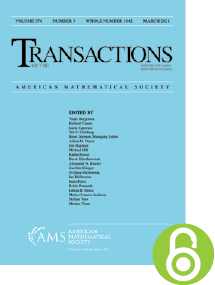The genera of amalgamations of graphs
HTML articles powered by AMS MathViewer
- by Seth R. Alpert PDF
- Trans. Amer. Math. Soc. 178 (1973), 1-39 Request permission
Abstract:
If $p \leq m$, n then ${K_m}{ \vee _{{K_p}}}{K_n}$ is the graph obtained by identify ing a copy of ${K_p}$ contained in ${K_m}$ with a copy of ${K_p}$ contained in ${K_n}$ . It is shown that for all integers $p \leq m$, n the genus $g({K_m}{ \vee _{{K_p}}}{K_n})$ of ${K_m}{ \vee _{{K_p}}}{K_n}$ is less than or equal to $g({K_m}) + g({K_n})$. Combining this fact with the lower bound obtained from the Euler formula, one sees that for $2 \leq p \leq 5,g({K_m}{ \vee _{{K_p}}}{K_n})$ is either $g({K_m}) + g({K_n})$ or else $g({K_m}) + g({K_n}) - 1$. Except in a few special cases, it is determined which of these values is actually attained.References
- Joseph Battle, Frank Harary, Yukihiro Kodama, and J. W. T. Youngs, Additivity of the genus of a graph, Bull. Amer. Math. Soc. 68 (1962), 565–568. MR 155313, DOI 10.1090/S0002-9904-1962-10847-7
- J. Ch. Boland, Embedding of graphs into orientable surfaces, Nederl. Akad. Wetensch. Proc. Ser. A 70=Indag. Math. 29 (1967), 33–44. MR 0211391, DOI 10.1016/S1385-7258(67)50005-7 J. Edmonds, A combinatorial representation for polyhedral surfaces, Notices Amer. Math. Soc. 7 (1960), 646. Abstract #572-1.
- William Gustin, Orientable embedding of Cayley graphs, Bull. Amer. Math. Soc. 69 (1963), 272–275. MR 145506, DOI 10.1090/S0002-9904-1963-10952-0
- Frank Harary, Graph theory, Addison-Wesley Publishing Co., Reading, Mass.-Menlo Park, Calif.-London 1969. MR 0256911, DOI 10.21236/AD0705364 I. N. Kagno, The mapping of graphs on surfaces, J. Math. and Phys. 16 (1937), 46-75.
- Jean Mayer, Le problème des régions voisines sur les surfaces closes orientables, J. Combinatorial Theory 6 (1969), 177–195. MR 234863, DOI 10.1016/S0021-9800(69)80118-3
- Gerhard Ringel, Färbungsprobleme auf Flächen und Graphen, Mathematische Monographien, vol. 2, VEB Deutscher Verlag der Wissenschaften, Berlin, 1959 (German). MR 0109349
- Gerhard Ringel and J. W. T. Youngs, Lösung des Problems der Nachbargebiete, Arch. Math. (Basel) 20 (1969), 190–201 (German). MR 242720, DOI 10.1007/BF01899013
- Gerhard Ringel and J. W. T. Youngs, Solution of the Heawood map-coloring problem, Proc. Nat. Acad. Sci. U.S.A. 60 (1968), 438–445. MR 228378, DOI 10.1073/pnas.60.2.438
- Gerhard Ringel and J. W. T. Youngs, Solution of the Heawood map-coloring problem—Case 11, J. Combinatorial Theory 7 (1969), 71–93. MR 240006, DOI 10.1016/S0021-9800(69)80008-6
- Gerhard Ringel and J. W. T. Youngs, Solution of the Heawood map-coloring problem—case 2, J. Combinatorial Theory 7 (1969), 342–352. MR 265216, DOI 10.1016/S0021-9800(69)80061-X
- Gerhard Ringel and J. W. T. Youngs, Solution of the Heawood map-coloring problem—case 8, J. Combinatorial Theory 7 (1969), 353–363. MR 262113, DOI 10.1016/S0021-9800(69)80062-1
- C. M. Terry, L. R. Welch, and J. W. T. Youngs, The genus of $K_{12s}$, J. Combinatorial Theory 2 (1967), 43–60. MR 206939
- C. M. Terry, L. R. Welch, and J. W. T. Youngs, Solution of the Heawood map-coloring problem—case $4$, J. Combinatorial Theory 8 (1970), 170–174. MR 258675, DOI 10.1016/S0021-9800(70)80074-6
- J. W. T. Youngs, The Heawood map coloring conjecture, Graph Theory and Theoretical Physics, Academic Press, London, 1967, pp. 313–354. MR 0236059
- J. W. T. Youngs, Minimal imbeddings and the genus of a graph, J. Math. Mech. 12 (1963), 303–315. MR 0145512
- J. W. T. Youngs, Solution of the Heawood map-coloring problem—case $3,\,5,\,6$, and $9$, J. Combinatorial Theory 8 (1970), 175–219. MR 258676, DOI 10.1016/S0021-9800(70)80075-8
- J. W. T. Youngs, The Heawood map-coloring problem—cases $1,\,7,\,$and$\,10$, J. Combinatorial Theory 8 (1970), 220–231. MR 258677, DOI 10.1016/S0021-9800(70)80076-X
Additional Information
- © Copyright 1973 American Mathematical Society
- Journal: Trans. Amer. Math. Soc. 178 (1973), 1-39
- MSC: Primary 05C10
- DOI: https://doi.org/10.1090/S0002-9947-1973-0371698-X
- MathSciNet review: 0371698


